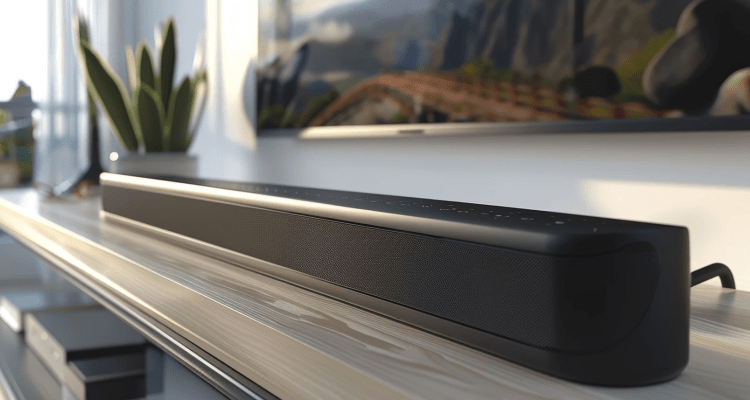If home theater choices feel like ordering at a taco truck—so many delicious options—you’re not alone. The big question: AV receiver + speakers or a soundbar? Here’s the friendly, no-jargon breakdown to help you pick the one that fits your room, your budget, and your sanity. You don’t need, a PhD to decide.
Related: What is an A/V Receiver
The Short Answer
Choose a soundbar if you want plug-and-play simplicity, better-than-TV sound, and a tidy living room. Choose an AV receiver (AVR) with speakers if you want bigger, clearer, more immersive sound with the ability to upgrade over time.
How They Differ
- Soundbars: A single speaker bar (often with a wireless sub) that sits under your TV. Easy setup, one cable, minimal settings. Some simulate surround; premium models include up-firing drivers for “virtual” Atmos.
- AV receiver systems: A receiver powers separate speakers (fronts, center, surrounds, sub). More boxes, more wires, way more control—and usually better sound per dollar once you get beyond entry-level.
Related: Denon AVR-570BT Review
AVR vs Soundbar: Quick Comparison
| Category | AV Receiver + Speakers | Soundbar |
|---|---|---|
| Setup | More boxes & cables; 30–90 minutes with basic calibration. | Plug-and-play; 10–20 minutes, minimal settings. |
| Sound Quality | Bigger, clearer, real surround; best dialog with a true center speaker. | Much better than TV; “virtual” surround varies by model/room. |
| Immersion (Movies/Games) | Excellent with 5.1/7.1 or Atmos speakers. | Good; premium bars with up-firing drivers can be impressive. |
| Music | Stereo imaging & depth; upgrade speakers anytime. | Convenient streaming; narrower soundstage. |
| Price Range | $$–$$$$ (scales from basic to audiophile). | $–$$$ (great value at mid-tier). |
| Living Space | Best for dedicated or larger rooms. | Best for apartments/bedrooms/tidy setups. |
| Expandability | Add sub(s), more speakers, new sources over time. | Usually limited to sub + rear add-ons (brand-specific). |
When a Soundbar Is Enough

- You’re upgrading from TV speakers: Any decent bar is a night-and-day improvement for dialog and clarity.
- You want zero fuss: One HDMI (eARC) cable, done. No receiver menus. No cable spaghetti.
- Small to medium rooms: Modern bars can fill everyday spaces without breaking a sweat.
- Shared walls: A bar with a modest sub keeps bass civilized and neighbor-friendly.
When You’ll Be Happier with an AV Receiver

- Movie-night fanatic: Real surround speakers beat virtual tricks for convincing effects and overhead moments.
- Music matters: Stereo speakers + AVR give instruments space and texture a bar can’t match.
- Bigger rooms: More air to move; proper speakers and a sub (or two) keep things clean and impactful.
- Upgrade bug: With an AVR you can swap speakers, add a turntable, or expand to Atmos later.
Gaming, HDMI, and Other “Will This Work?” Stuff
Gamers: look for 4K/120, VRR, and low input lag. Many recent soundbars handle next-gen consoles via TV eARC, while AVRs often include multiple HDMI 2.1 inputs so you can plug everything into the receiver and switch sources easily.
Living with Each Choice
Soundbar life: Fewer remotes, fewer arguments, fewer holes in the wall. AVR life: A one-time effort to set up, followed by years of “wow, that sounds good” and a satisfying upgrade path.
Decision Guide (Super Simple)
- Apartment + simplicity + streaming? Soundbar.
- Suburban living room + movie/music lover? AVR + speakers.
- Unsure? Try a premium soundbar first—most stores have forgiving return policies. If you crave more, step up to an AVR later.
Cost Clarity Without the Math Headache
- Good soundbar: $$ gets you clarity, dialog boost, and a compact sub.
- Starter AVR package: $$$ buys a receiver + 5.1 speakers that already outclass similarly priced bars for immersion.
- Enthusiast route: Add a better sub and center speaker later—biggest audible upgrades for movies.
Handy Tips
- Use eARC: If your TV and system support it, you’ll get cleaner audio from TV apps (Netflix, Disney+).
- Dialog first: Whether bar or AVR, bump the “dialog/center” level +1–2 dB for clearer speech.
- Sub placement: Start near the front wall, not jammed in a corner; run auto-calibration if available.
- Wall-mount smartly: If you mount a soundbar, keep it within a few inches of the TV’s bottom edge so voices feel anchored to the screen.
- Future-proof lightly: Don’t overbuy. If you don’t game, you don’t need 4K/120. If you do, check those specs.
- Measure your media console: Make sure the bar’s height won’t block the TV’s IR sensor—or plan on a little IR repeater.
- Room wins over specs: Proper placement and basic calibration usually beat chasing bigger numbers.
Bottom line: If you want instant gratification with minimal clutter, a soundbar will make you smile. If you want cinema vibes, real surround, and an upgrade path, go AVR + speakers—you’ll smile even wider.
